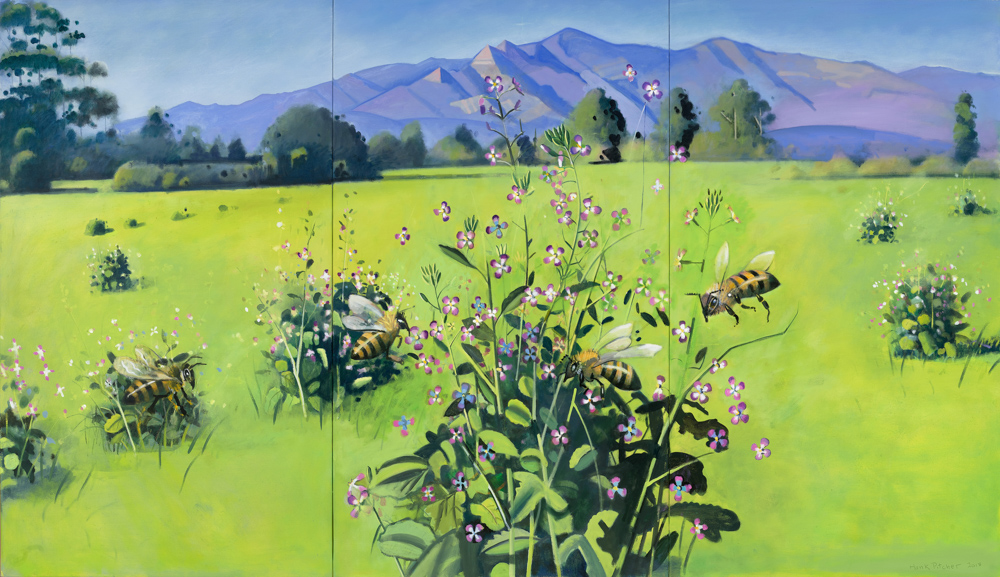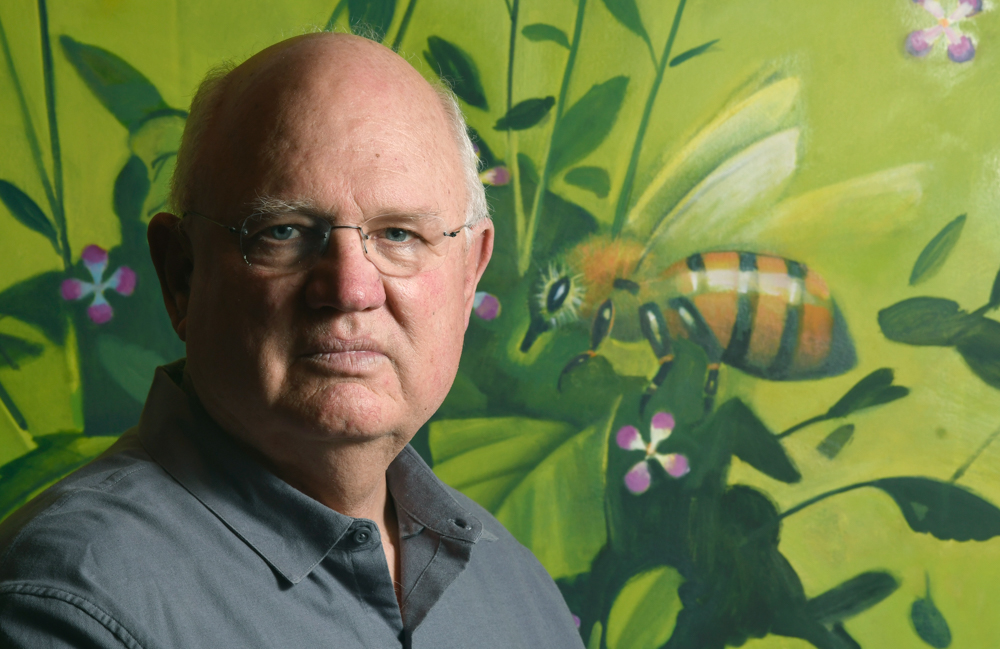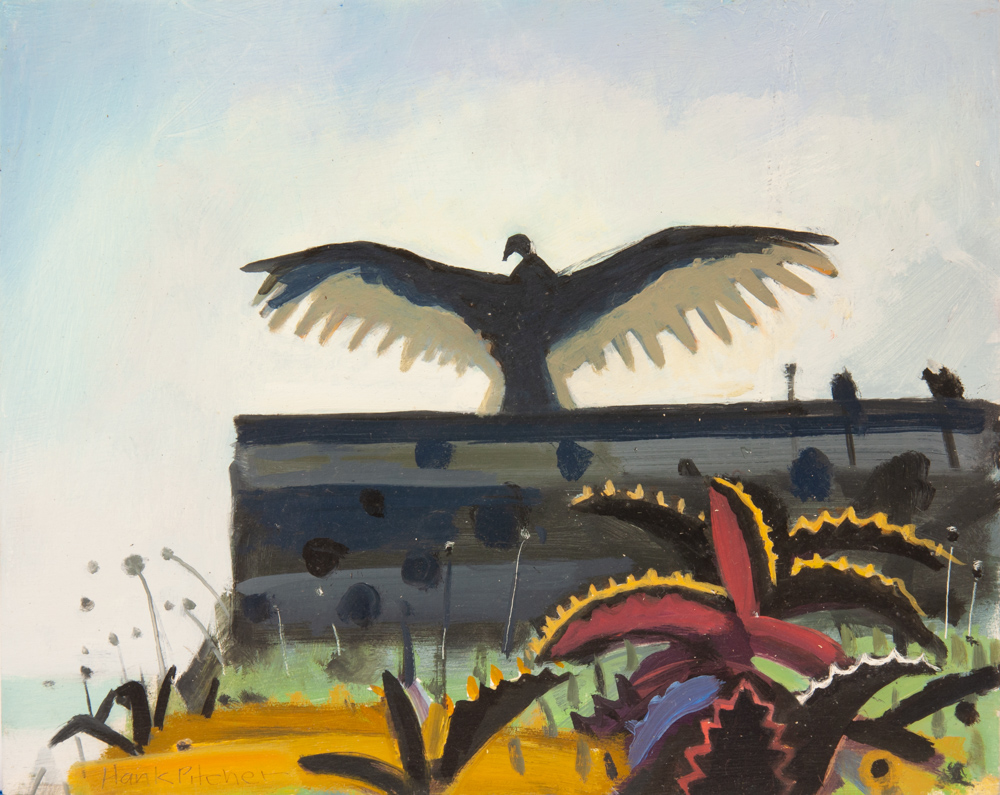Artist Hank Pitcher Goes ‘Primal’ at Sullivan Goss
New Work Confronts Issues of Recovery, Environment, and Immigration

“Whatever’s going on in the world ends up in your work. I like the idea of painters being witnesses — of showing truth as it is. I like painters being able to develop and discover an image of who we are.” This is how Hank Pitcher describes the intention behind his latest work, an exhilarating and career-defining series that’s now on view at Sullivan Goss in a show called Primal. After writing a story about the venerated painter in this paper two years ago, Pitcher and I have become best friends. He’s invited me to his studio for long chats about art and life. Late last spring in 2018, when Pitcher summoned me to see his latest work, he mentioned on the phone that it was a response to the disasters of January 2018. Bracing for the worst, I drove to his studio expecting bleak images of nature devastated. Instead my heart stopped as I walked into his workspace. Yes, I could see the landscape paintings he’s known for, as well as his iconic surfboards. Yet I saw canvases bursting with exhilarating colors and kinetic compositions that instilled a visceral reaction like I’d never experienced before in Pitcher’s oeuvre. Most importantly, I understood the complexity to this set of paintings, comprising three different groups. Each of them deals with one of three important issues that our community — and our nation — is currently grappling with: immigration, the environment, and recovery from disaster. “All of these things are fundamental issues,” says Pitcher. “You look back to nature for answers. What are the essential issues? Making these paintings brings these questions up. I’m not trying to make political statements. Those political statements are in nature.”
Over the past six weeks, Pitcher and I met three times to discuss Primal, this sacred and profane new series that he started painting in February 2018.
January 16, 2019 — Immigration
“Everything is about everything else,” is how Pitcher greets me on an evening with heavy rain. Yet we share a sigh of relief that the storm hasn’t caused major damage like the year before. He’s quoting marine biotechnologist Dr. Kathy Foltz, who was interim dean of the College of Creative Studies at UCSB, where Pitcher has been teaching for decades. “In a welcome speech to the students at the beginning of her tenure, she said that ‘everything is about everything else,’ and I love that description of the interconnectedness of things. I love that it applies equally to atoms, parts of a painting, and to our place on the planet. Working with and sometimes teaching with the scientists at UCSB has informed my work and inspired me. I find that scientists tend to be much more creative and curious than artists.”
I stare at a particular group of paintings that are set in Point Conception. When he steps up on that Point, Pitcher can see his studio at UCSB — and the whole Gaviota Coast. “The winds blow so hard I have to hide in the weeds,” he explains. “There used to be a giant Victorian house up there. That’s a square piece of land which has mystical meaning for the Chumash. It is the gateway to the Western world.” He tells me there’s always some weird cloud formation. There’s a temperature differential on either side of the point — sometimes referred to as the “elbow for California” — for this is where the cold current coming out of the Pacific from Japan meets the warmer current of the Channel Islands. “I feel like a white man there,” Pitcher confides. “I feel like I’m on somebody else’s territory. Sometimes I feel at peace there, but most of the time it’s strange.” One of the most remarkable things about the flat part of Point Conception is the way that in the Point’s short spring between March and May, and at the same time when the wind blows its hardest, all varieties of different native and non-native plants are blooming at once. “It’s a funny metaphor for immigration issues,” observes Pitcher. “Simultaneously you have native Giant Coreopsis as well as aloes and ice plants from the coast of South Africa. The ice plant is invasive — it has just taken over a lot of grazing now that it has become ‘naturalized.’ When this simultaneous blooming of native and non-native plants happens, there’s a cacophony of colors and shapes. I’m looking at this same landscape and seeing it differently. I’m able to observe. This endangered plant blooms with these plants that are not native. The ice plant becomes stressed at this point. This idea of what is native — what should stay and what should go — is on my mind. How do you allow all the dreamers — if you allow everyone in? This is something that gets acted out in the landscape. I really don’t have an answer at all. The more I learn about ecology and the environment, the harder the question becomes. Where do you draw the line when something is not native?”
Besides the urgency in the themes of Pitcher’s new paintings, I notice something else unusual. Most of his paintings in his long career have been about the light at the end of the day. “Like the fall, the end of the day is about reflection,” he says. But these new paintings are about spring and depict the world as it appears in morning light, when things are in bloom.
“I think we’re in the beginning of something in our culture,” Pitcher reflects. “Something is blooming — the power of new life. I’m going to turn 70 this year. I’m still not able to fully accept that I can no longer physically do the things I did when I was in my twenties. I’m not physically strong enough to ride those waves anymore. One of the reasons I always wanted to be a painter was because I could do it until the very end. For a painter, the last paintings are the best paintings. I realize I’m at the beginning of a new stage in my life. What I can do now as an artist is take this talent and skill I’ve accumulated and decide what else I can do with it. As an artist, I feel something has just begun.”
January 21 — Recovery — ‘Creation versus Destruction’

Pitcher and I met again on the Martin Luther King Jr. Day holiday, and as I pulled up to his studio, he pointed out the total lunar eclipse. Later, when I ask about the painting titled “Bees and Wild Radishes,” he says that it is his response to last year’s fires. The work bursts with a life force, the Dionysian energy of spring. Bees circle pollen-bearing wild radishes in euphoria. The painting is so visceral you can hear the buzzing. Passion and danger mix in this landscape. “I capture that moment when it’s springtime and everything is fighting for attention and propagation,” says Pitcher. “The fire is the end of things, but there’s new life after. It’s a competition for light, and all of that that makes for an incredible beauty — all of that stuff blooming.”
Pitcher explains that in paintings, spring is usually represented as bucolic and pretty, “but when you see something being born, there’s the fighting for life — coming out of the ground and fighting for space. Flowers are all about sex. It’s like a party — all about rituals and plumage.”
“Between what was happening politically and the fires and the mudslide, the best way I could react to it was to do something very positive,” he reflects. “I felt the same way during the Vietnam War. For a while, I felt guilty that I didn’t drop out of college and go to battle, fighting in the war or protesting the war. I finally realized that the best thing I could do was to make the best art that I could make. In a way it was the story of Mars and Venus, but it was more about believing that we have to fight for art, for truth and beauty, to keep it alive, in the best way we can. I think of making art as creation versus destruction. So I painted bees making honey. I understood the importance of painting and stories about peaceful times instead of death.”
“People in Santa Barbara make paintings of landscapes so pretty — so cloying and saccharine,” says Pitcher. “There’s chaos in my paintings. There’s an energy to this life that includes death and destruction.”
The color palette in the Primal paintings is new for Pitcher’s art. “Magenta and orange are so rich, juicy,” he exults. “There are not many opportunities when you can put those colors together. Green and purple. It could easily become a psychedelic poster. I wanted it to be sensuous — strange chords coming together. I couldn’t have thought of going on that journey before. I go from yellow to pink. I kept wondering, How far can you push it before it becomes garish? How hot can the sauce be before it becomes too hot? Prior to these paintings, my palette was in the blue spectrum.” He reveals that when the color is just right, “I can feel what it’s like to be there. I’ve been reading about the Impressionists. They didn’t paint about impressions, but rather about sensations — how nature stimulated them. When I work on big, complex paintings, I live with them and make little adjustments.”
January 28 — The Environment
“My works speaks to a spirituality,” says Pitcher. “I paint landscapes that are beautiful, mysterious. Greeks had divinities for places. Santa Barbara — this area I’ve painted my entire life — is so incredible, so precious, so beautiful. The more I travel, the more beautiful this place becomes. By painting these things as extraordinary things, I’m preserving them. They’re the opposite of postcard paintings of Santa Barbara, which actually devalue the place.”
The last group of paintings in Primal return to the blue spectrum palette and depict both sand dunes in the Coal Oil Preserve and the classic monolithic Pitcher surfboard. “The Burning Spear” showcases a Hamish Graham design. The stomp pad, with the leash cord that attaches to the ankle, recalls a bee’s antennae. In Pitcher’s work, everything is about everything. “All of my paintings are about me, aspects of me,” he says. “They represent what I get caught up in.”
But the main focus of these artworks is on the sand dunes in Coal Oil point. “I was so uncomfortable making these paintings,” the artist reveals about his perspective. “It was unnatural for me turn my back to the ocean.” The Coal Oil Point Reserve is part of the University of California Natural Reserve System. Largely undisturbed coastal dunes support a rich assortment of dune vegetation and rare wildlife, including the dune spider, the globose dune beetle, and the threatened western snowy plover. “They’ve put a fence around the sand dunes,” Pitcher says. “You get these beautiful ripples on the sand where there are no footprints. You notice footprints of beetles and birds.” Not allowing people on the sand dunes has allowed the snowy plovers to recover. They too have blossomed.
Some activists want access to preserves for public access and recreation. “It’s such a sensitive habitat,” Pitcher states. “If you allow unlimited access, it would destroy it. It is a very complicated issue. Santa Barbara beachfront is as nice as it is because the community restricted and oversaw development. I have known developers over the years who hated the zoning restrictions and the Architectural Board of Review, but look at what a mess most of Southern California coast is because there was too little oversight.

“The other very big issue is preserving nature and natural habitats. During my lifetime, I have seen the beaches around Coal Oil Point change from a remarkably rich shoreline teeming with clams and lobster and abalone and crab to what is now, in comparison, a desert. At low tide, I see crowds of people with buckets and sticks killing and collecting what little sea life is left in the tide pools. They leave behind trash that kills more animals. Most of the birds are gone. It is rare to see a shell on the beach anymore. How do we decide how many and what people are allowed to go on the beaches that are still alive? Are we willing to lose what little natural landscape we have left? I have been fortunate growing up here to get to know people who have let me visit their private property to paint areas that have not been ruined. I hope that by celebrating these areas, that may help in some ways to preserve these places. I am against artists who make pictures of the undeveloped land around us that look like they are real estate ads. I think these landscapes should be shown as the homes of plants and animals and geography that we must preserve, that we must leave alone. There are a lot of places that I have not been able to get to, but, knowing how delicate some of these environments are, I would be willing to give up ever going there if that would help protect them.”
4•1•1
Hank Pitcher: Primal is on view at Sullivan Goss, An American Gallery (11 E. Anapamu St.)
through April 21. See sullivangoss.com and hankpitcher.com



